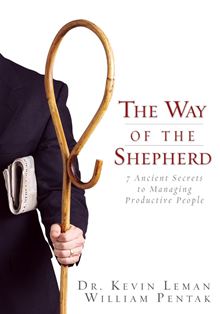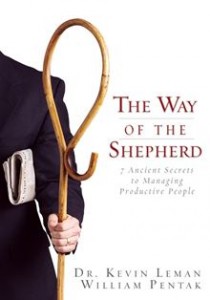
How Sheep Form Exceptional Business Leaders
March 7, 2013Did you ever meet a leader that seemed to inspire and challenge everyone around them?
Recently, I read a great book that was easy to read and very engrossing to me as a business owner, leader and coach, called: The Way of the Shepherd.
It’s beautifully articulated by Dr. Kevin Leman and William Pentak.
Ironically, this phenomenal business leadership book was lent to me by Phil Hernandez, who is the senior pastor at In the Light Ministries, and an empowered shepherd. I find that in this fast-paced cynical culture we live in one wouldn’t typically expect to accrue such practical business and career wisdom from a spiritual leadership source.
Top Nuggets I Gleaned from The Way of the Shepherd:
Although there was a lot that I took away from this book, I want to impart certain highlights that stood out to me. I pray they are insightful, paradigm shifting, convicting and inspiring above all things as they were for me. As I do this review, I find them serving as wonderful reminders in my career as a CEO and international business/life coach/speaker.
I was truly blessed to read this and I am excited to share some of the best wisdom I gleaned from it. This post will give you a starting road-map to help teach you how to your lead the people around you so they will view their work as a calling rather than merely a job, a place to belong to a cause / movement rather than simply a place to work. This work is revelatory in showing us how to infuse work with deep meaning and teaching us how to engage and energize your workforce in a vibrant new way as you walk into your future destiny. For those that are willing to think differently, heed wisdom and change first from within, there are truly no boundaries to your future!
The Interview
- “He expects the best from us, and we give it to him because we know he’s giving his best to us in return.” – pg.10
- He had an engaging personality and listened intently to everything I said –pg.11
Chapter 1
- “…always know the condition of your flock…make a point of knowing not just the status of the work but also the status of your people.” –pg. 25
- Your people are your greatest competitive advantage. Managers will say they agree with that, but often they merely give lip service to the idea. –pg. 26
- You need to know their goals and dreams, what motivates them when they walk through the door in the morning, what their career ambitions and frustrations are. …you have to make a point of knowing what things are impacting them at the moment.
- As best you can, keep up with what’s going on in the lives of your people.
- “You have to really care about your people. You can go through all the right mechanics, but if you don’t genuinely care about the people who report to you, you’ll never be the kind of leader they’ll drop everything to follow.” –pg. 27
- …people don’t care how much you know until they know how much you are. –pg.28
Chapter 2
- …I always tried to make sure that anyone I interviewed was a good fit both for the company and for the position. I also wanted to make sure that my existing employees fit their positions well too. –pg. 32
- SHAPE— S-Strengths— try to place people where they can operate out of their strengths and not their weaknesses
- H-Heart—I want to know what my people are passionate about. If I put them in areas that reflect their passions, they’ll arrive to work like they’ve been shot out of a cannon. They’ll begin to think of their job more as a cause than as a place to draw a paycheck.
- A-Attitude–…people with a good attitude are usually team players. For another, they usually have a teachable spirit.
- …what if the person with the bad attitude also happens to be your best performer? What do you do then? You get rid of them?
- …people with negative attitudes don’t have a learner’s heart. (pgs. 33,34)
- P-Personality—-Some people thrive on structure. Some thrive on change. The point is to put a person in a position that reflects his or her personality. –pg. 37
- E-Experience—-Each person you meet is in part shaped by their life experiences.
- …if you want to find your calling in life, at the very least, you want to make sure you’re working in an area where you have the greatest potential for success, then take a look at your SHAPE and make sure that you’re a good fit for your job. –pg. 39
Chapter 3
- …the effectiveness of my little flock, as well as the fulfillment of each person in it, depended on what kind of a shepherd-leader I would be. Pg. 41
- Like sheep, people have a powerful flocking instinct. They have a tremendous need to belong. Great leaders understand that instinct and tap into it. –pg. 45
- …it’s good to stretch ourselves every now and then so that we’re always growing. …if we don’t, we won’t know what we’re capable of. –pg. 48
- “People long to follow a leader who is a person of integrity, authenticity, and compassion. That person will have the loyal following and trust of his people.”
- “Great leaders leave their mark by constantly communicating their values and sense of mission. They tirelessly call their people to engage in the cause.” –pg. 49
- …don’t forget to ask for their commitment to the cause….you can’t make your mark on the people you lead unless you get up close and personal. –pg. 50
- …to influence, to really leave your mark, you’re going to have to do it personally. –pg. 51
Chapter 4
- If you don’t feel secure at work, there’s no way you can do your best work. You do that by keeping your people well informed. If there’s bad news, let your people hear it from you first. –pg. 58
- Keep your people informed on their progress before review time. That way they won’t be surprised if they receive a negative review, and more importantly, they’ll have an opportunity to improve their performance by the time the formal review rolls around. –pg. 59
- …infuse every position with importance. People will be less apt to vie for position if they feel as though their current position has a degree of significance. –pg. 60
- …rotate opportunities among the different members of your flock. That way they won’t feel a need to fight for them. –pg. 61
- “Sheep will not lie down unless they are free from fear, rivalry, pests… and hunger. Like sheep, we also hunger, but for different things.” –pg. 63
- “…be visible. Don’t be an absentee shepherd.” Nothing reassures the sheep more than the presence of the shepherd. –pg. 64
- People can handle the uncertainty of tomorrow if they can see a leader they are certain they can trust today.
- “Don’t give problems time to fester…” –pg. 65
Chapter 5
- “First, when directing your people, use persuasion, not coercion. Instead of making pronouncements, make requests. Offer suggestions and ideas. Don’t dictate and demand; instead, advocate and recommend.”
- …when people do mess up, rather than pound them into the ground, like boss did, use the incident as a teaching opportunity. –pg. 72
- You provide direction and set expectations, then let your people decide how best to get there. –pg. 74
- “No matter how hard you try to keep everyone together and headed in the right direction, some people are still going to wander off and get in trouble.
- It’s up to you as their shepherd to get them out of trouble. When you do, you’ll be amazed at their loyalty to you and the trust they’ll place in you. –pg. 76
- “Good shepherds don’t forget to encourage their people…” –pg. 78
Chapter 6
- …but that’s what a good shepherd does. He stands in the gap for his sheep. –pg. 85
- You discipline your people, not to harm them, but to keep them from harm. –pg. 90
- …guide the person in a course correction without alienating them, and that depends on how you approach the conversation. –pg. 90
- “…it’s your duty…to regularly inquire about the progress of your people, because you’re responsible for developing them.” –pg. 93
- You can say all day long, come to me if you have any problems, but chances are the members of your flock who need help the most will be the ones who are least likely to ask for it. –pg. 93
- “If a person never indicates they need help when you inquire about their progress, it means either that they don’t trust you enough to be honest with you or that you haven’t sufficiently challenged them to grow. –pg. 93
Chapter 7
- What distinguishes a great leader from a mediocre one is that a great leader has a heart for his people. –pg. 101
- The quality of your return is based on the quality of your investment. If you want your people to return loyalty and trust to you, you first have to invest loyalty and trust in them. –pg. 106
The End of the Interview
- So a key to maintaining your competitive advantage is to retain your talent. –pg. 110
- Great leadership comes at a price that too few are willing to pay. –pg. 111
My Main Takeaways to Become a Shepherd Leader:
You need to have a healthy balance between commanding respect from your team while ensuring you give them the best of your heart as you establish essential trust within each of them. Here are two insights from the book that I believe are your next steps to begin taking action to transform your leadership style into shepherd leadership!
- “The staff represents your responsibility to direct your people; the rod represents your responsibility to correct them. This is the part of leadership that leaders, particularly new ones, most commonly err on. If you use the rod too much or incorrectly, you’ll lose the goodwill of your people. Use it too little or not at all, and you’ll lose their respect. – pg. 84
- “If you don’t have a heart for your people, you’ll look at them differently than someone who does. You’ll see them as expenses and interruptions, and you’ll never invest yourself in them like a shepherd would.” –pg. 102
I strongly encourage you to read this and share it with your team or key client relationships. I believe it will deepen your key relationships in life if you heed the wisdom and apply it to your life. I also believe it would be a great client gift that could help bolster the on-going fruit in your top client relationships this year and beyond.
So what is one thing you can commit to now with regard to focusing more on giving in your life? If you have any questions about any of these insights or how to adapt them to your world, feel free to contact me or the authors.
